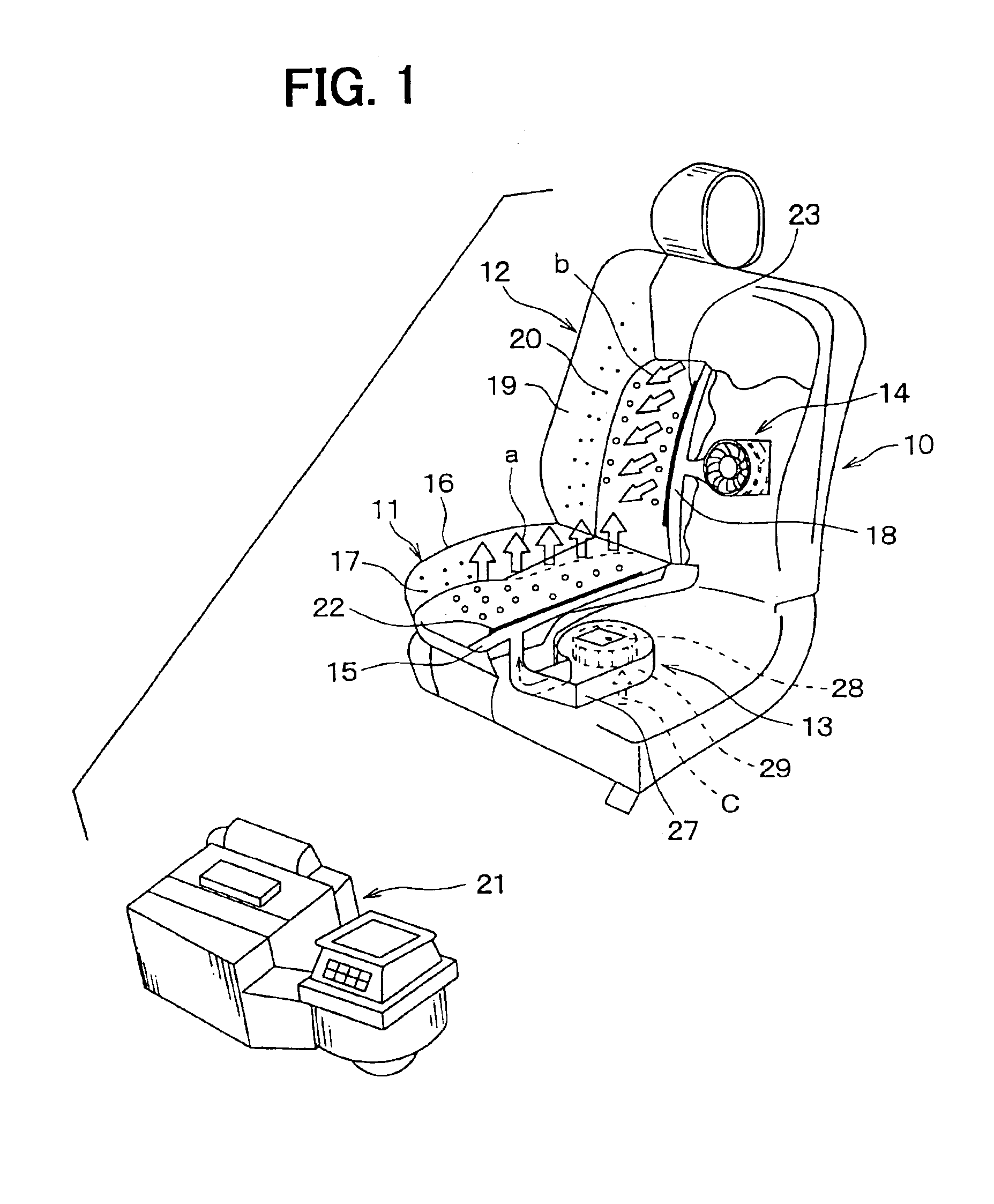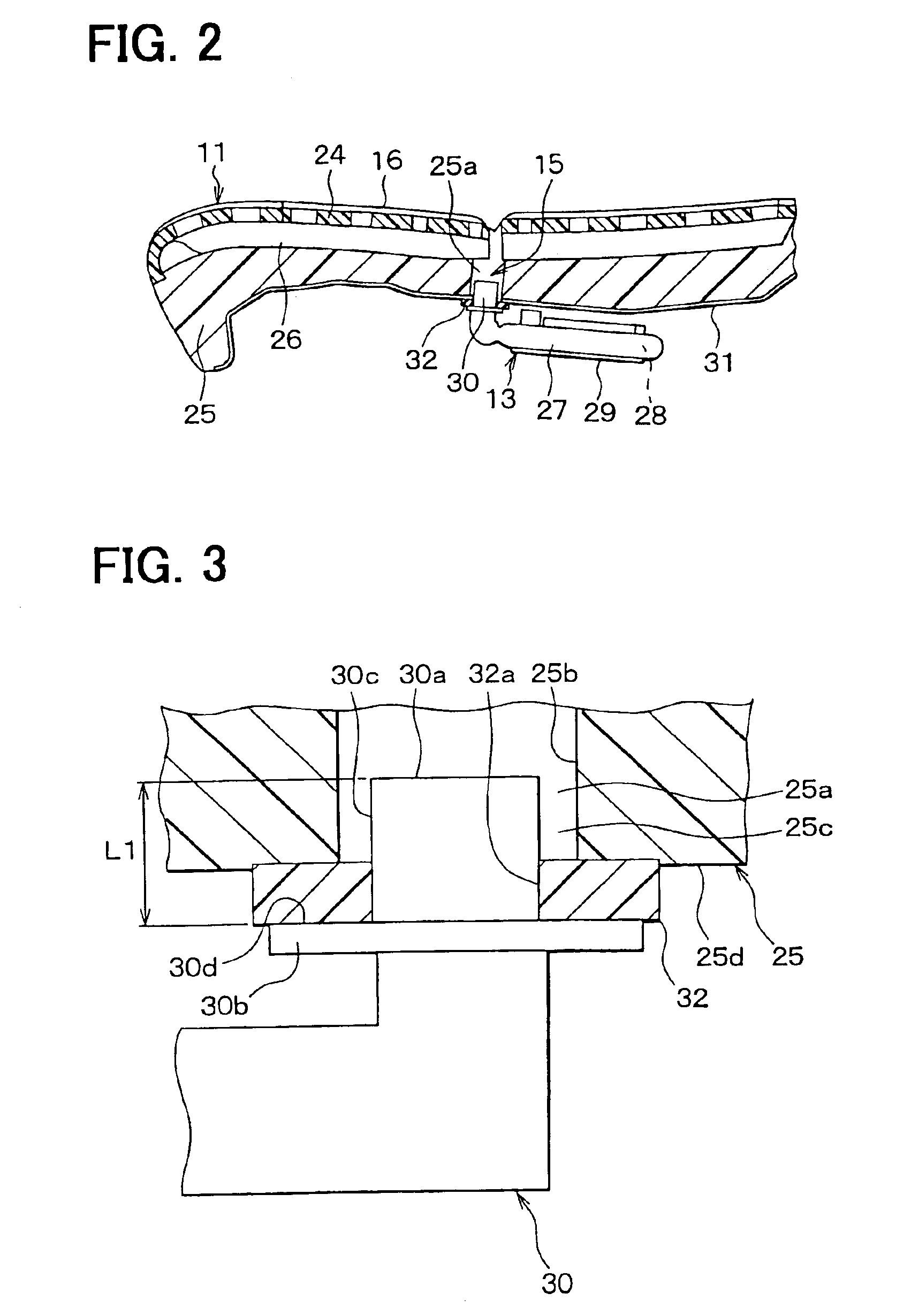Vehicle seat air conditioning system
- Summary
- Abstract
- Description
- Claims
- Application Information
AI Technical Summary
Benefits of technology
Problems solved by technology
Method used
Image
Examples
first embodiment
(First Embodiment)
[0032]FIG. 1 shows a vehicle seat 10, which has a vehicle seat air conditioning system according to a first embodiment of the present invention. The vehicle seat 10 shown in FIG. 1 is practically used as a driver seat or front-passenger seat of a vehicle.
[0033]The vehicle seat 10 includes a seat cushion arrangement 11 and a seat back arrangement 12. The seat cushion arrangement 11 supports buttocks of an occupant (not shown) in the seat 10, and the seat back arrangement 12 supports a back of the occupant. First and second blower units 13, 14 are arranged in the seat cushion arrangement 11 and the seat back arrangement 12, respectively.
[0034]The first blower unit 13 draws air from a vehicle passenger compartment through a circular air intake opening 29 (FIG. 3) of the first blower unit 13 located at a lower side of the seat cushion arrangement 11. The air drawn from the air intake opening 29 is then conducted to a surface cover member 16 of the seat cushion arrangem...
second embodiment
(Second Embodiment)
[0056]In the first embodiment, the buffering member 32 is provided to the end surface 25d of the cushion member 25, which is located on the first blower unit 13 side of the cushion member 25. In a second embodiment, as shown in FIG. 4, a cylindrical buffering member 32 is provided to the inner peripheral surface 25b of the through hole 25a. More specifically, the cylindrical buffering member 32 is radially positioned and is clamped between the distal end outer peripheral surface 30c of the discharge duct 30 and the inner peripheral surface 25b of the through hole 25a.
[0057]Here, the buffering member 32 can be air tightly adhered to the inner peripheral surface 25b of the through hole 25a by adhesive (not shown). Also, the buffering member 32 can be air tightly adhered to the outer peripheral surface 30c of the discharge duct 30 by adhesive (not shown).
third embodiment
(Third Embodiment)
[0058]In the first and second embodiments, the buffering member 32 is used to restrain conduction of vibrations from the first blower unit 13 to the cushion member 25. In a third embodiment, as shown in FIG. 5, a damping flange (serving as a buffering member) 25e, which has an annular shape and projects radially inward in the through hole 25a is used in place of the buffering member 32 discussed in the first or second embodiment.
[0059]The damping flange 25e is formed integrally with the cushion member 25 and has a central through hole 25f in its center and a predetermined thickness, i.e., a vertical length in FIG. 5. The distal end outer peripheral surface 30c of the duct 30 is directly inserted into the central through hole 25f of the damping flange 25e.
[0060]The damping flange 25e does not necessarily mean the flange 25e that has the through hole 25f with a circular cross section but can be a flange that has a central through hole with an elliptic cross section,...
PUM
 Login to View More
Login to View More Abstract
Description
Claims
Application Information
 Login to View More
Login to View More - R&D
- Intellectual Property
- Life Sciences
- Materials
- Tech Scout
- Unparalleled Data Quality
- Higher Quality Content
- 60% Fewer Hallucinations
Browse by: Latest US Patents, China's latest patents, Technical Efficacy Thesaurus, Application Domain, Technology Topic, Popular Technical Reports.
© 2025 PatSnap. All rights reserved.Legal|Privacy policy|Modern Slavery Act Transparency Statement|Sitemap|About US| Contact US: help@patsnap.com



